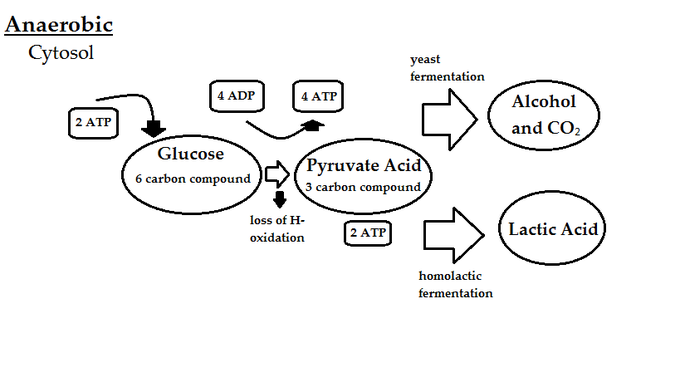Which of the Following Can Be Used as Electron Acceptors During Anaerobic Respiration
five.9A: Electron Donors and Acceptors in Anaerobic Respiration
- Page ID
- 8976
In anaerobic respiration, a molecule other than oxygen is used equally the terminal electron acceptor in the electron transport chain.
Learning Objectives
- Describe various types of electron acceptors and donors including: nitrate, sulfate, hydrgoen, carbon dioxide and ferric iron
Key Points
- Both inorganic and organic compounds may be used as electron acceptors in anaerobic respiration. Inorganic compounds include sulfate (SO4 ii-), nitrate (NOthree –), and ferric iron (Feiii+). Organic compounds include DMSO.
- These molecules have a lower reduction potential than oxygen. Therefore, less energy is formed per molecule of glucose in anaerobic versus aerobic conditions.
- The reduction of certain inorganic compounds by anaerobic microbes is oft ecologically significant.
Key Terms
- anaerobic: Without oxygen; specially of an environment or organism.
- reduction: A reaction in which electrons are gained and valence is reduced; often by the removal of oxygen or the add-on of hydrogen.
- anaerobic respiration: metabolic reactions and processes that have identify in the cells of organisms that employ electron acceptors other than oxygen
Anaerobic respiration is the formation of ATP without oxygen. This method however incorporates the respiratory electron transport chain, simply without using oxygen as the final electron acceptor. Instead, molecules such as sulfate (Then4 2-), nitrate (NO3 –), or sulfur (S) are used as electron acceptors. These molecules take a lower reduction potential than oxygen; thus, less energy is formed per molecule of glucose in anaerobic versus aerobic weather.

Many unlike types of electron acceptors may be used for anaerobic respiration. Denitrification is the utilization of nitrate (NO3 −) every bit the terminal electron acceptor. Nitrate, like oxygen, has a high reduction potential. This process is widespread, and used by many members of Proteobacteria. Many denitrifying bacteria can also utilize ferric iron (Fe3+) and different organic electron acceptors.
Sulfate reduction uses sulfate (SO2 −4) every bit the electron acceptor, producing hydrogen sulfide (H2S) every bit a metabolic finish product. Sulfate reduction is a relatively energetically poor process, and is used past many Gram negative leaner found within the δ-Proteobacteria. It is also used in Gram-positive organisms related to Desulfotomaculum or the archaeon Archaeoglobus.
Sulfate reduction requires the use of electron donors, such every bit the carbon compounds lactate and pyruvate (organotrophic reducers), or hydrogen gas (lithotrophic reducers). Some unusual autotrophic sulfate-reducing leaner, such every bit Desulfotignum phosphitoxidans, can use phosphite (HPOiii –) as an electron donor. Others, such as sure Desulfovibrio species, are capable of sulfur disproportionation (splitting 1 chemical compound into an electron donor and an electron acceptor) using elemental sulfur (S0), sulfite (SO3 −two), and thiosulfate (Due south2Oiii ii-) to produce both hydrogen sulfide (HiiS) and sulfate (SO2−).
Acetogenesis is a type of microbial metabolism that uses hydrogen (H2) as an electron donor and carbon dioxide (CO2) equally an electron acceptor to produce acetate, the same electron donors and acceptors used in methanogenesis.
Ferric iron (Iron3+) is a widespread anaerobic terminal electron acceptor used by both autotrophic and heterotrophic organisms. Electron flow in these organisms is like to those in electron ship, ending in oxygen or nitrate, except that in ferric fe-reducing organisms the final enzyme in this system is a ferric iron reductase. Since some ferric iron-reducing bacteria (e.yard.G. metallireducens) can utilise toxic hydrocarbons (eastward.chiliad. toluene) equally a carbon source, at that place is significant interest in using these organisms as bioremediation agents in ferric atomic number 26 contaminated aquifers.
Other inorganic electron acceptors include the reduction of Manganic ion (Mnfour+) to manganous (Mn2+), Selenate (SeO4 2−) to selenite (SeOthree 2−) to selenium (Se), Arsenate (AsO4 3−) to arsenite (AsOiii iii-), and Uranyl (UOtwo 2+) to uranium dioxide (UO2)
Organic compounds may also exist used every bit electron acceptors in anaerobic respiration. These include the reduction of fumarate to succinate, Trimethylamine N-oxide (TMAO) to trimethylamine (TMA), and Dimethyl sulfoxide (DMSO) to Dimethyl sulfide (DMS).
Source: https://bio.libretexts.org/Bookshelves/Microbiology/Book%3A_Microbiology_(Boundless)/5%3A_Microbial_Metabolism/5.09%3A_Anaerobic_Respiration/5.9A%3A_Electron_Donors_and_Acceptors_in_Anaerobic_Respiration
0 Response to "Which of the Following Can Be Used as Electron Acceptors During Anaerobic Respiration"
Post a Comment